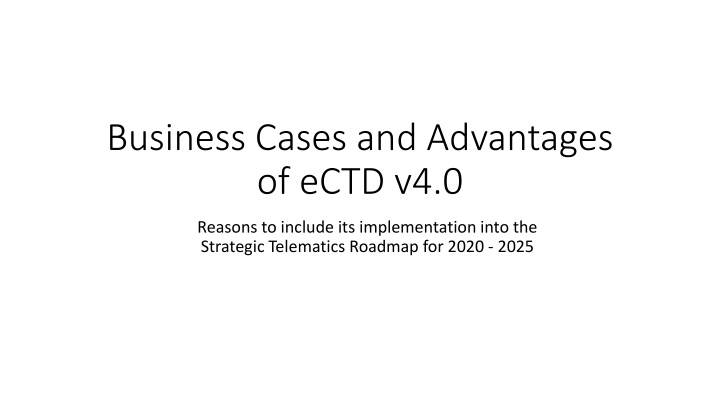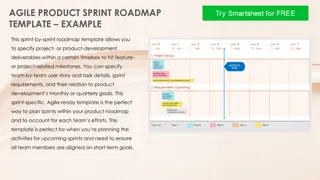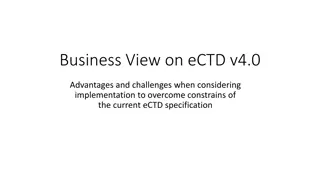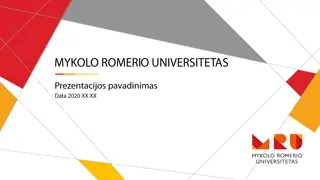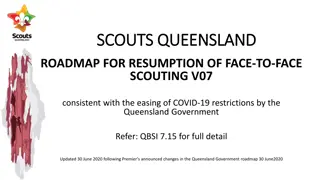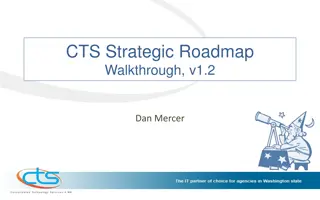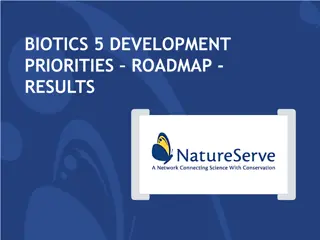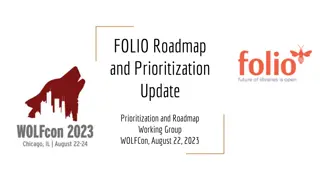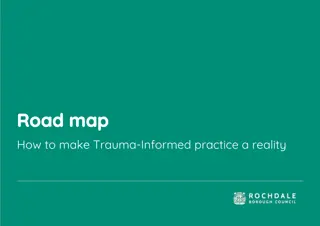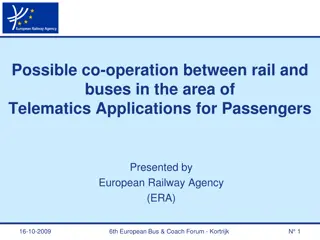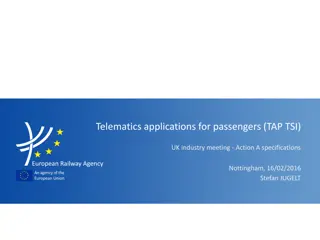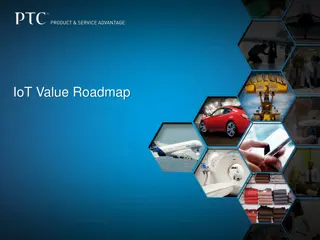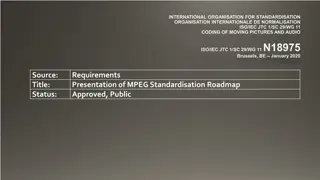The Advantages of Implementing eCTD v4.0 into the Strategic Telematics Roadmap
eCTD v4.0 offers several benefits such as harmonized submission units, document re-use through unique identifiers, enhanced life cycle management, and controlled vocabularies for easier updates. It facilitates grouping of documents based on context of use and keywords, automates administrative processing, adapts to new legal requirements, allows electronic submissions for various product types, and reduces maintenance efforts for regulators. Overall, its implementation can streamline submission processes and enhance regulatory efficiency.
Download Presentation

Please find below an Image/Link to download the presentation.
The content on the website is provided AS IS for your information and personal use only. It may not be sold, licensed, or shared on other websites without obtaining consent from the author.If you encounter any issues during the download, it is possible that the publisher has removed the file from their server.
You are allowed to download the files provided on this website for personal or commercial use, subject to the condition that they are used lawfully. All files are the property of their respective owners.
The content on the website is provided AS IS for your information and personal use only. It may not be sold, licensed, or shared on other websites without obtaining consent from the author.
E N D
Presentation Transcript
Business Cases and Advantages of eCTD v4.0 Reasons to include its implementation into the Strategic Telematics Roadmap for 2020 - 2025
Advantages of eCTD v4.0 (1) Harmonised submission unit: All content from Module 1 through Module 5 is contained in one exchange message i.e., an XML file covers both ICH and regional information. Document re-use: Once a document has been submitted, the document may be reused by referencing its unique identifier (ID) from the same or different submission. Allows re-use of meta-data (e.g., document title, language, media type) All the contents of the reused document, including references and hypertext links to other documents, should be relevant to any submission that uses it again. Context of Use life cycle: The Context of Use concept allows for advanced life cycle management operations. A Context of Use may be replaced by one or more Context of Use elements and vice versa (i.e., one to many, many to one) through the context of use life cycle. eCTD v4.0 also introduces the ability to apply changes to keyword definition display name values (e.g., drug substance/product names, manufacturers, dosage forms, indication, excipient, group title) without resubmitting the physical files or the Context of Use element. 2 ICH M8 eCTD v4.0 Orientation Material
Advantages of eCTD v4.0 (2) Function of context of use and keyword combinations: The Context of Use and Keyword combination will function to create a group of documents. It will enable the flexible creation of groups of documents with common links: for example same API, clinical studies or development programmes. Controlled vocabularies (CVs): Allowed values are captured in CVs providing for easier update without the need for system or tool updates. This allows changes due to e.g. new legislation, Brexit, etc. within a time frame of few weeks instead of several months for transition. For sender-defined keyword values, previously submitted values can be corrected/replaced in subsequent submissions Additional document metadata Document metadata may be used to identify submission content (e.g., datasets) that require additional processing 3 ICH M8 eCTD v4.0 Orientation Material
How eCTD 4.0 can Help Regulators 1. Automation of administrative processing 2. Submission of content relevant for more than one dossier / application 3. Implementation of new legal requirements / modification of the dossier structure to adapt better to new business requirements 4. Electronic submission required for regulated product types other than human medicinal products 5. Much less maintenance effort for submission management and reviewing tools Details on each topic will be presented on the following pages
1. Automation of Administrative Processing Although some improvements of the current eCTD specification are already contributing to an easier automated processing, the situation for grouped submissions of all kinds is laborious to manage and at risk for error. Referencing across applications will reduce workload substantially because technical validation of additional submissionunit.xml files can be automated. Currently, the same content is required to be submitted several times (for example in procedures such as work-sharing, DCP/ MRP). An immediate local benefit of using eCTD 4.0 correctly is that duplicates must no longer be stored in the same national repositories. Even greater benefit will of course be achieved by setting up a common EU dossier repository because it would save on the storage overhead for the EU Regulatory Network, and fully enable inter-submission cross-referencing of content. eCTD 4.0 can make it possible to indicate that submitted content has received agency assessment, and what the outcome was. Such information could save further review and assessment work.
3. Grouped Submissions (all kinds of grouping, worksharing, PSUR, ASMF) Example on how to use the same content for more than one dossier Provision of separate submissionunit.xml files of involved applications, submitted in one container to get all information same time The submissionunit.xml will contain contextOfUse elements only for one application and references the document element UUIDs included from e.g. fr1762 submissionunit.xml by which the files are provided No need to store the short life of such a regulatory activity separately No need for additional rules for specific folder names
3. Implementation of New Legal Requirements In the past the adoption of new legal requirements for EU electronic submission content was highly expensive as the eCTD v3.2.2 software code was necessary to be modified resulting in new releases of the DTD, extensive system validation effort and repeated QC of its implementation by all stakeholders. Modification of the dossier structure to adapt better to new business requirements was mostly realised by workarounds or postponed until the next major version of the eCTD publishing/ review tool became available. Any kind of changing the granularity was impossible.
4. Electronic submission required for regulated product types As it was not possible to use the eCTD specification for other than human medicinal products, no one was considering whether and how the messaging standard RPS could have been applied for medical devices, clinical trial applications, veterinary medicinal products and so on. As the presentation of content is completely controlled by the contextOfUse elements defined in a controlled vocabulary, simply the controlled vocabulary needs to be exchanged to adapt the software to the needs of any other product type. The RPS messaging standard fits to all. A common tool, free of use, would allow to use one technical solution for all as well.
5. Maintenance of the software The implement a new version of the specification of eCTD namely for EU regionally or for m2 to m5 at ICH level was restricted to very rare occasions as it was very costly and always a complex project activity requiring long planning periods in advance. Following eCTD v4.0 no further maintenance of the software is to be expected. All modification will be executed by adapting the controlled vocabularies instead of updating the software. Following the switch to eCTD v4.0 software and executing the transition all previously submitted content can be used further on. There is no need to re-work the existing structure of local storage.
Forward Compatibility from v3.2. to v4.0 Transition (not a migration) Based on Regulator s Current View One time transition mapping of IDs Works for eCTD v3.2.2 content, but will not replace a decision on baselining Mapping previous leaf IDs to new contextOfUse IDs will allow further use and re-use in eCTD v4.0 messages No need to modify previously stored sequences or dossiers Principle: eCTD v 4.0 document ID Backbone type eCTD v3.2.2 Leaf ID Sequence
With eCTD v4.0, you can (for industry) Re-use documents submitted previously, Correct information (e.g. display name or document title) easily, Group documents within a CTD section in a consistent way across ICH regions, Change document granularity while maintaining life cycle relationships, Set the order of documents within a CTD section, Identify submission content (e.g., datasets) for additional processing, and Transition current content in v3.2.2 to v4.0 and continue eCTD life cycle in v4.0. 11 ICH M8 eCTD v4.0 Orientation Material
New Opportunities Compared to v3.2.2 Reduced maintenance efforts as no more software updates are required to address regulatory changes without delay due to the extensive use of controlled vocabularies can achieve this immediately Simplification of life cycle as all activities will be managed by the contextOfUse element Flexibility of dossier granularity and grouping of documents due to priority number and the option of group titles within a section defined by a combination of contextOfUse element and keywords Referencing documents across applications by using the UUID independently from the structure of the storage area at receiver s end Two way communication as a future option to exchange information without media breaks and presenting content life cycle consistently at sender s and reeceiver s end Applicability to all kind of products without the need for software reconfiguration because only a different controlled term list for contexOfUse terms is required
Pre-requisites The benefit-cost-ratio needs to be calculated Agencies which are currently don t use an eCTD reviewing tool need to implement or need to have access to at least a simple viewing tool Considering that IT developments will move from a document based towards a data based submission an impact analysis how eCTD v4.0 will interact with IDMP implementation, application dataset usage for eAF or product databases for medicinal products.
